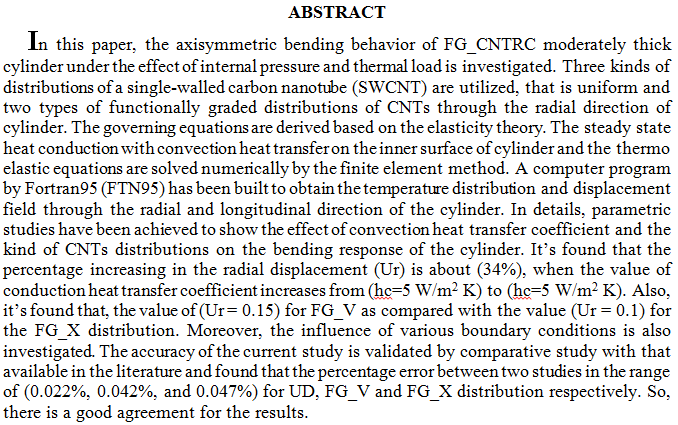
In this work, wide band range photo detector operating in UV, Visible and IR was fabricated using carbon nanotubes (MWCNTs, SWCNTs) decorated with silver nanoparticles (Ag NPs). Silicon was used as a substrate to deposited CNTs/Ag NPs by the drop casting technique. Polyamide nylon polymer was used to coat CNTs/Ag NPs to enhance the photo-response of the detector. The electro-exploding wire technology was used to synthesize Ag NPs. Good dispersion of silver NPs achieved by a simple chemistry process on the surface of CNTs. The optical, structure and electrical characteristic of CNTs decorated with Ag NPs were characterized by X-Ray diffraction and Field Emission Scanning Electron Microscopy. X-ray diffra
... Show MoreThe current research aims to determine the impact of the cognitive reconstruction program on the development of psychological hardness among middle school students through the experimental verification of three hypotheses. The research sample consisted of (16) out of (450) students selected from Ibn Rushud preparatory school- Al-Rusafa 2. These participants have been randomly distributed into two equal groups. The researcher has used the method of cognitive reconstruction with the experimental group, whereas with the controlling group, he used nothing. The researcher has further used the scale of psychological hardness of Kobassa with the participants; the scale has been built in a way that suits the sample of the study, which consisted
... Show MoreCarbon nanoparticles are prepared by sonication using carbon black powder. The surface morphology of carbon black (CB) and carbon nanoparticles (CNPs) is investigated using scanning electron microscopy (SEM). The particles size ranges from 100 nm to 400 nm for CB and from 10 nm to 100 nm for CNPs. CNPs and CB are mixed with silicon glue of different ratios of 0.025, 0.2, 0.05, and 0.1 to synthesis films. The optical properties of the prepared films are investigated through reflectance and absorbance analyses. The ratio of 0.05 for CNPs and CB is the best for solar paint because of its higher solar water heater efficiency and is then added to the silicon glue . Temperature of cold water and temperature of hot water in storage tank were ta
... Show MoreIn this research, the size strain plot method was used to estimate the particle size and lattice strain of CaTiO3 nanoparticles. The SSP method was developed to calculate new variables, namely stress, and strain energy, and the results were crystallite size (44.7181794 nm) lattice strain (0.001211), This method has been modified to calculate new variables such as stress and its value (184.3046308X10-3Mpa) and strain energy and its value (1.115833287X10-6 KJm-3).
 (7)
(7)
 (5)
(5)
Concrete columns with hollow-core sections find widespread application owing to their excellent structural efficiency and efficient material utilization. However, corrosion poses a challenge in concrete buildings with steel reinforcement. This paper explores the possibility of using glass fiber-reinforced polymer (GFRP) reinforcement as a non-corrosive and economically viable substitute for steel reinforcement in short square hollow concrete columns. Twelve hollow short columns were meticulously prepared in the laboratory experiments and subjected to pure axial compressive loads until failure. All columns featured a hollow square section with exterior dimensions of (180 × 180) mm and 900 mm height. The columns were categorized into
... Show More (2)
(2)
 (2)
(2)
The ground state proton, neutron, and matter density distributions and corresponding root-mean-square radii (rms) of the unstable neutron-rich
22C exotic nucleus are investigated by two-frequency shell model (TFSM) approach. The single-particle wave functions of harmonic-oscillator (HO)
potential are used with two oscillator parameters bcore and bhalo. According to this model, the core nucleons of 20C are assumed to move in the model
space of spsdpf. Shell model calculations are performed with (0+2)hw truncations using Warburton-Brown psd-shell (WBP) interaction. The outer (halo) two neutrons in 22C are assumed to move in HASP (H. Hasper) model space (2s1/2, 1d3/2, 2p3/2, and 1f7/2 orbits) using the HASP interaction. The halo st
 (39)
(39)
 (40)
(40)
In this study, simply supported reinforced concrete (RC) beams were analyzed using the Extended Finite Element Method (XFEM). This is a powerful method that is used for the treatment of discontinuities resulting from the fracture process and crack propagation in concrete. The mesoscale is used in modeling concrete as a two-phasic material of coarse aggregate and cement mortar. Air voids in the cement paste will also be modeled. The coarse aggregate used in the casting of these beams is a rounded aggregate consisting of different maximum sizes. The maximum size is 25 mm in the first model, and in the second model, the maximum size is 20 mm. The compressive strength used in these beams is equal to 26 MPa.
The subje
... Show More (3)
(3)
